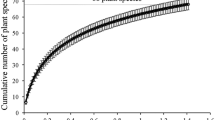Abstract
A group of Callicebus torquatus lugens using a territory of 22.25 ha in eastern Colombia showed a varied diet throughout the annual period of lowest fruit availability. This is a time when the females are usually pregnant. During a 6-month period the study group's diet consisted of 59.4% fruits, 26.9% immature seeds, 6.4% leaves, 3.9% flowers, and 3.4% insects and spiders. At the fruit bottleneck, consumption of seeds and flowers increased, while consumption of leaves and insects showed no particular trend. They ate 62 species of plants: 45 for flesh, 6 for seeds, 2 for flowers, and 13 for foliage. The most important families in terms of species chosen are Moraceae (8 species, or 11 species if Cecropiaceae is included), Myristicaceae (7), Arecaceae (4), Chrysobalanaceae (4), and Euphorbiaceae. The most important families in terms of feeding time are Myristicaceae (25%), Euphorbiaceae (15%), Moraceae (14%), and Arecaceae (9%). Of 440 marked feeding trees in the territory of the group, 41.1% are represented by Sandwithia heterocalyx (Euphorbiaceae). This species is the most important food in the diet and has the highest density of all food trees in the home range. It followed by Heterostemon conjugates (Caesalpiniaceae) (10%), Iryanthera ulei (Myristicaceae) (6.1%), Anaxagorea brachycarpa (Annonaceae) (5.9%), and Iryanthera crassifolia (Myristicaceae) (3.4%). The remaining 33.5% of the marked trees are represented by the other 57 species. In terms of time spent feeding, the important trees in the diet include Sandwithia heterocalyx (13.9%), Virola melinonii (10%), Iryanthera ulei (8.35%), Oenocarpus bataua (7.06%), and Heterostemon conjugates (6.53%). We suggest that Callicebus torquatus should be described as a frugivore–granivore; they share with the Pitheciin an immature seed-eating adaptation.
Similar content being viewed by others

References
Altmann, J. (1974). Observational study of behavior: Sampling methods. Behavior 49: 227–65.
Defler, T. R. (1983). Some population characteristics of Callicebus torquatus lugens (Humboldt, 1812) (Primates: Cebidae) in eastern Colombia. Lozania 38: 1–9.
Defler, T. R. (1995). The time budget of a group of wild woolly monkeys (Lagothrix lagothricha). Int. J. Primatol. 16: 107–120.
Defler, T. R., and Defler, S. (1996). The diet of a group of woolly monkeys (Lagothrix lagothricha lagothricha) in southeastern Colombia. Int. J. Primatol. 17: 161–190.
Easley, S. P. (1982). Ecology and behavior of Callicebus torquatus, Cebidae Primates, Ph.D. thesis, Washington University, St. Louis.
Easley, S. P., and Kinzey, W. G. (1986). Teritorial shift in the yellow-handed titi monkey (Callicebus torquatus). Am. J. Primatol. 11(4): 307–318.
Forero, O. (1987). Contribucion al conocimiento del uso espacial de Callicebus torquatus lugens en el bajo no Apaporis, Vaupes, Bachelor's thesis, Pontificia Universidad Javeriana, Santafe de Bogota.
Kinzey, W. G. (1977). Diet and feeding behavior of Callicebus torquatus. In Clutton-Brock, T. H. (ed.), Primate Ecology: Studies of Feeding and Ranging Behavior in Lemurs, Monkeys, and Apes. Academic Press, London, pp. 127–151.
Kinzey, W. G. (1978). Feeding behaviour and molar features in two species of titi monkeys. In Chivers, D. J., and Herbert, J. (eds.), Recent Advances in Primatology, Vol 1. Behaviour, Academic Press, London, pp. 373–385.
Kinzey, W. G. (1981). The titi monkeys, genus Callicebus. In Coimbra-Filho, A. F., and Mittermeier, R. A. (eds.), Ecology and Behaviour of Neotropical Primates, Academia Brasileira de Ciencias, Rio de Janeiro, pp. 241–276.
Kinzey W. G., and Norconk, M. A. (1990). Hardness as a basis of fruit choice in two sympatric primates. Am. J. Phys. Anthropol. 81: 5–15.
Kinzey W. G., and Norconk, M. A. (1993). Physical and chemical properties of fruit and seeds eaten by Pithecia and Chiropotes in Surinam and Venezuela. Int. J. Primatol, 14: 207–227.
Kinzey W. A., Norconk, M. A., and Leighton, M. (1990). Preliminary data on physical and chemical properties of fruit eaten by Pithecia pithecia. Am. J. Primatol. 20: 204–205.
Ludwig, J., and Reynolds, J. (1988). Statistical Ecology: A Primer on Methods and Computing, John Wiley and Sons, New York.
Matteucci, D., and Colma, A. (1982). Metodologia para el estudio de la vegetacion, Monograph OEA, No. 122, Washington, D. C.
Palacios, E., and Rodriguez, A. (1995). Caracterizacion de la Dieta y Comportamiento Alimentario de Callicebus torquatus lugens, Bachelor's thesis, Universidad National de Colombia, Santafe de Bogota.
Robinson, J. G. (1981). Spatial structure in foraging groups of wedge-capped capuchin monkeys, Cebus nigrivittatus. Anim. Behav. 29: 1036–1056.
Terborgh, J. (1983). Five New World Primates, Princeton University Press, Princeton, NJ.
van Roosmalen, M. G. M. (1984). Subcategorizing foods in primates. In Chivers, D. J., Wood, B. A., and Bilsborough, A. (eds.), Food Acquisition and Processing in Primates, Plenum Press, New York, pp. 167–175.
Author information
Authors and Affiliations
Rights and permissions
About this article
Cite this article
Palacios, E., Rodríguez, A. & Defler, T.R. Diet of a Group of Callicebus torquatus lugens (Humboldt, 1812) During the Annual Resource Bottleneck in Amazonian Colombia. International Journal of Primatology 18, 503–522 (1997). https://doi.org/10.1023/A:1026307121583
Issue Date:
DOI: https://doi.org/10.1023/A:1026307121583



